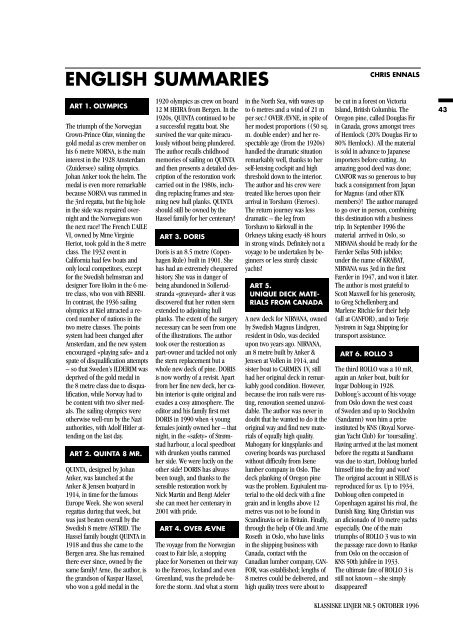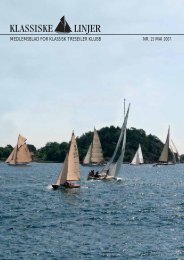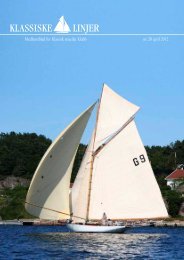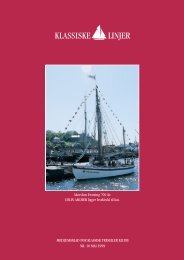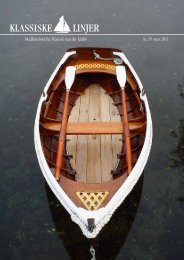KLASSISKE LINJER - Klassisk Treseiler Klubb
KLASSISKE LINJER - Klassisk Treseiler Klubb
KLASSISKE LINJER - Klassisk Treseiler Klubb
You also want an ePaper? Increase the reach of your titles
YUMPU automatically turns print PDFs into web optimized ePapers that Google loves.
ENGLISH SUMMARIES<br />
ART 1. OLYMPICS<br />
The triumph of the Norwegian<br />
Crown-Prince Olav, winning the<br />
gold medal as crew member on<br />
his 6 metre NORNA, is the main<br />
interest in the 1928 Amsterdam<br />
(Zuidersee) sailing olympics.<br />
Johan Anker took the helm. The<br />
medal is even more remarkable<br />
because NORNA was rammed in<br />
the 3rd regatta, but the big hole<br />
in the side was repaired overnight<br />
and the Norwegians won<br />
the next race! The French L’AILE<br />
VI, owned by Mme Virginie<br />
Heriot, took gold in the 8 metre<br />
class. The 1932 event in<br />
California had few boats and<br />
only local competitors, except<br />
for the Swedish helmsman and<br />
designer Tore Holm in the 6 metre<br />
class, who won with BISSBI.<br />
In contrast, the 1936 sailing<br />
olympics at Kiel attracted a record<br />
number of nations in the<br />
two metre classes. The points<br />
system had been changed after<br />
Amsterdam, and the new system<br />
encouraged «playing safe» and a<br />
spate of disqualification attempts<br />
– so that Sweden’s ILDERIM was<br />
deprived of the gold medal in<br />
the 8 metre class due to disqualification,<br />
while Norway had to<br />
be content with two silver medals.<br />
The sailing olympics were<br />
otherwise well-run by the Nazi<br />
authorities, with Adolf Hitler attending<br />
on the last day.<br />
ART 2. QUINTA 8 MR.<br />
QUINTA, designed by Johan<br />
Anker, was launched at the<br />
Anker & Jensen boatyard in<br />
1914, in time for the famous<br />
Europe Week. She won several<br />
regattas during that week, but<br />
was just beaten overall by the<br />
Swedish 8 metre ASTRID. The<br />
Hassel family bought QUINTA in<br />
1918 and thus she came to the<br />
Bergen area. She has remained<br />
there ever since, owned by the<br />
same family! Arne, the author, is<br />
the grandson of Kaspar Hassel,<br />
who won a gold medal in the<br />
1920 olympics as crew on board<br />
12 M HEIRA from Bergen. In the<br />
1920s, QUINTA continued to be<br />
a successful regatta boat. She<br />
survived the war quite miraculously<br />
without being plundered.<br />
The author recalls childhood<br />
memories of sailing on QUINTA<br />
and then presents a detailed description<br />
of the restoration work<br />
carried out in the 1980s, including<br />
replacing frames and steaming<br />
new hull planks. QUINTA<br />
should still be owned by the<br />
Hassel family for her centenary!<br />
ART 3. DORIS<br />
Doris is an 8.5 metre (Copenhagen<br />
Rule) built in 1901. She<br />
has had an extremely chequered<br />
history. She was in danger of<br />
being abandoned in Sollerudstranda<br />
«graveyard» after it was<br />
discovered that her rotten stern<br />
extended to adjoining hull<br />
planks. The extent of the surgery<br />
necessary can be seen from one<br />
of the illustrations. The author<br />
took over the restoration as<br />
part-owner and tackled not only<br />
the stern replacement but a<br />
whole new deck of pine. DORIS<br />
is now worthy of a revisit. Apart<br />
from her fine new deck, her cabin<br />
interior is quite original and<br />
exudes a cosy atmosphere. The<br />
editor and his family first met<br />
DORIS in 1990 when 4 young<br />
females jointly owned her – that<br />
night, in the «safety» of Strømstad<br />
harbour, a local speedboat<br />
with drunken youths rammed<br />
her side. We were lucily on the<br />
other side! DORIS has always<br />
been tough, and thanks to the<br />
sensible restoration work by<br />
Nick Martin and Bengt Adeler<br />
she can meet her centenary in<br />
2001 with pride.<br />
ART 4. OVER ÆVNE<br />
The voyage from the Norwegian<br />
coast to Fair Isle, a stopping<br />
place for Norsemen on their way<br />
to the Færoes, Iceland and even<br />
Greenland, was the prelude before<br />
the storm. And what a storm<br />
in the North Sea, with waves up<br />
to 6 metres and a wind of 21 m<br />
per sec.! OVER ÆVNE, in spite of<br />
her modest proportions ((50 sq.<br />
m. double ender) and her respectable<br />
age (from the 1920s)<br />
handled the dramatic situation<br />
remarkably well, thanks to her<br />
self-lensing cockpit and high<br />
threshold down to the interior.<br />
The author and his crew were<br />
treated like heroes upon their<br />
arrival in Torshavn (Færoes).<br />
The return journey was less<br />
dramatic – the leg from<br />
Torshavn to Kirkwall in the<br />
Orkneys taking exactly 48 hours<br />
in strong winds. Definitely not a<br />
voyage to be undertaken by beginners<br />
or less sturdy classic<br />
yachts!<br />
ART 5.<br />
UNIQUE DECK MATE-<br />
RIALS FROM CANADA<br />
A new deck for NIRVANA, owned<br />
by Swedish Magnus Lindgren,<br />
resident in Oslo, was decided<br />
upon two years ago. NIRVANA,<br />
an 8 metre built by Anker &<br />
Jensen at Vollen in 1914, and<br />
sister boat to CARMEN 1V, still<br />
had her original deck in remarkably<br />
good condition. However,<br />
because the iron nails were rusting,<br />
renovation seemed unavoidable.<br />
The author was never in<br />
doubt that he wanted to do it the<br />
original way and find new materials<br />
of equally high quality.<br />
Mahogany for kingsplanks and<br />
covering boards was purchased<br />
without difficulty from Isene<br />
lumber company in Oslo. The<br />
deck planking of Oregon pine<br />
was the problem. Equivalent material<br />
to the old deck with a fine<br />
grain and in lengths above 12<br />
metres was not to be found in<br />
Scandinavia or in Britain. Finally,<br />
through the help of Ole and Arne<br />
Roseth in Oslo, who have links<br />
in the shipping business with<br />
Canada, contact with the<br />
Canadian lumber company, CAN-<br />
FOR, was established; lengths of<br />
8 metres could be delivered, and<br />
high quality trees were about to<br />
CHRIS ENNALS<br />
be cut in a forest on Victoria<br />
Island, British Columbia. The<br />
Oregon pine, called Douglas Fir<br />
in Canada, grows amongst trees<br />
of Hemlock (20% Douglas Fir to<br />
80% Hemlock). All the material<br />
is sold in advance to Japanese<br />
importers before cutting. An<br />
amazing good deed was done;<br />
CANFOR was so generous to buy<br />
back a consignment from Japan<br />
for Magnus (and other KTK<br />
members)! The author managed<br />
to go over in person, combining<br />
this destination with a business<br />
trip. In September 1996 the<br />
material arrived in Oslo, so<br />
NIRVANA should be ready for the<br />
Færder Seilas 50th jubilee;<br />
under the name of KRABAT,<br />
NIRVANA was 3rd in the first<br />
Færder in 1947, and won it later.<br />
The author is most grateful to<br />
Scott Maxwell for his generosity,<br />
to Greg Schellenberg and<br />
Marlene Ritchie for their help<br />
(all at CANFOR), and to Terje<br />
Nystrøm in Saga Shipping for<br />
transport assistance.<br />
ART 6. ROLLO 3<br />
The third ROLLO was a 10 mR,<br />
again an Anker boat, built for<br />
Ingar Dobloug in 1928.<br />
Dobloug´s account of his voyage<br />
from Oslo down the west coast<br />
of Sweden and up to Stockholm<br />
(Sandamn) won him a prize<br />
instituted by KNS (Royal Norwegian<br />
Yacht Club) for ‘toursailing’.<br />
Having arrived at the last moment<br />
before the regatta at Sandhamn<br />
was due to start, Dobloug hurled<br />
himself into the fray and won!<br />
The original account in SEILAS is<br />
reproduced for us. Up to 1934,<br />
Dobloug often competed in<br />
Copenhagen against his rival, the<br />
Danish King. King Christian was<br />
an aficionado of 10 metre yachts<br />
especially. One of the main<br />
triumphs of ROLLO 3 was to win<br />
the passage race down to Hankø<br />
from Oslo on the occasion of<br />
KNS 50th jubilee in 1933.<br />
The ultimate fate of ROLLO 3 is<br />
still not known – she simply<br />
disappeared!<br />
<strong>KLASSISKE</strong> <strong>LINJER</strong> NR.5 OKTOBER 1996<br />
43


